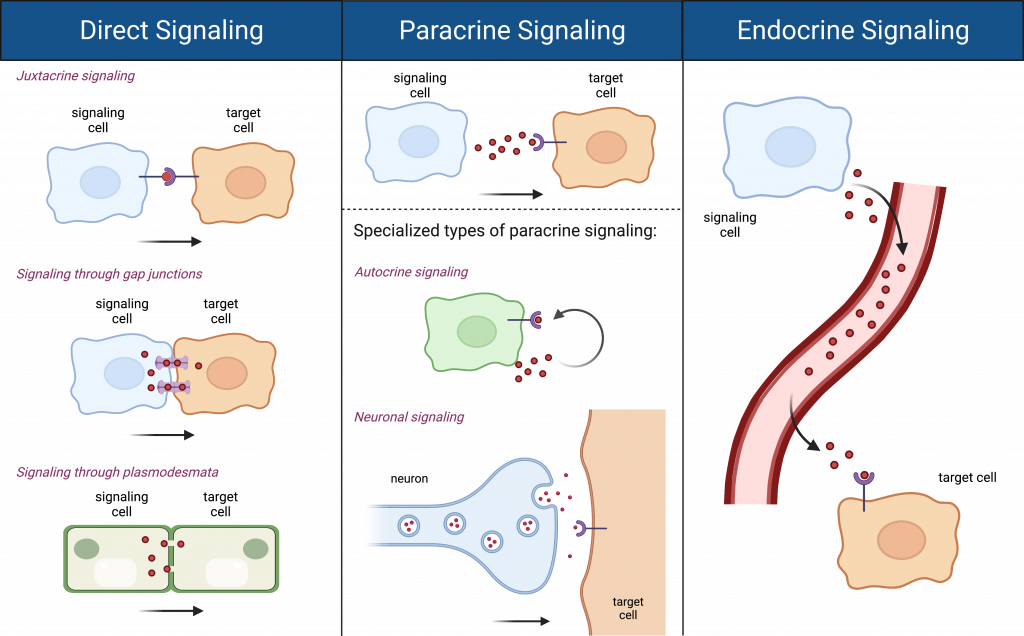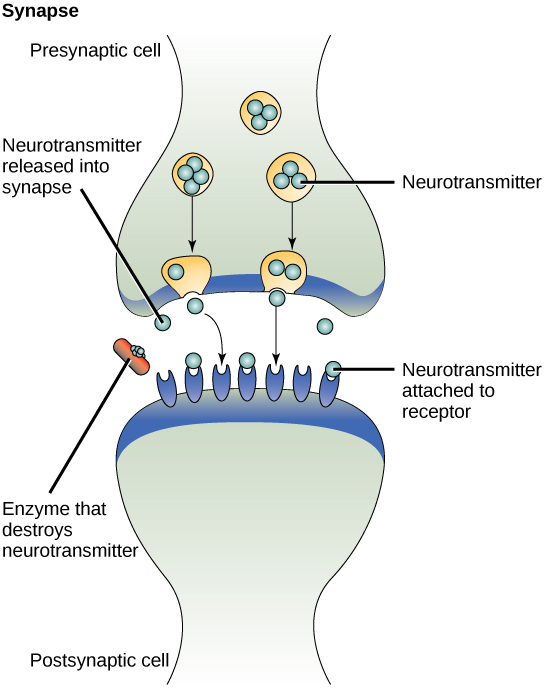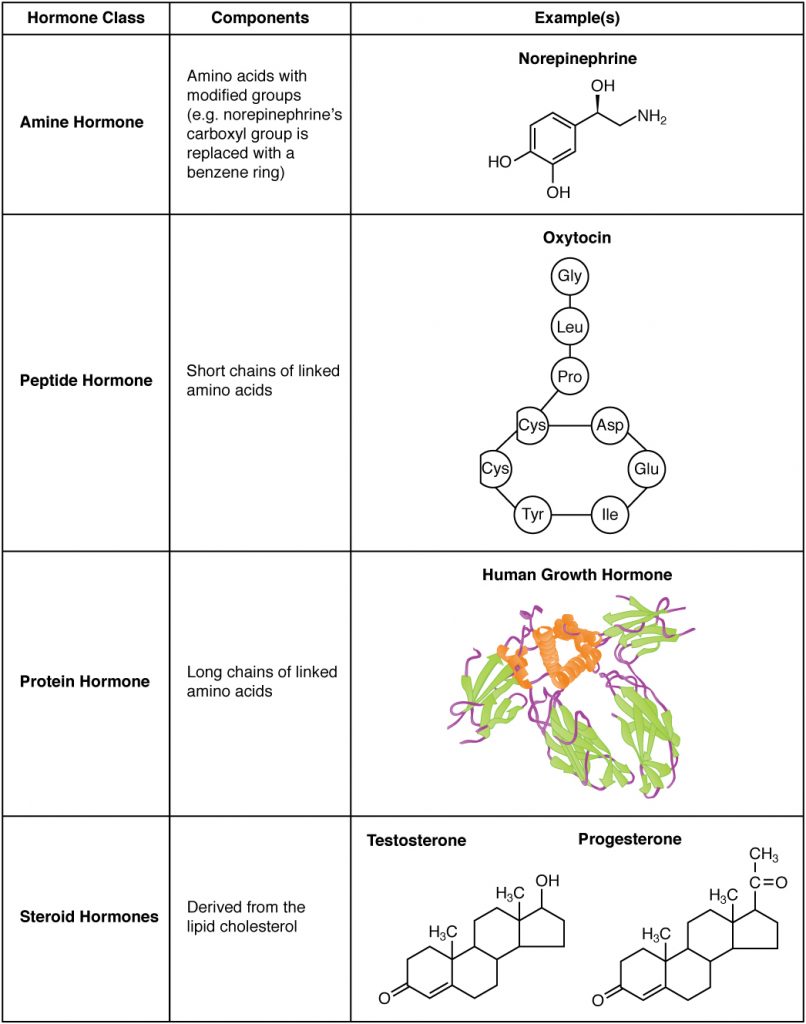11.2 Types of Cell Signaling
Signaling found in multicellular organisms can be divided into three main classes: direct signaling, paracrine signaling, and endocrine signaling. These categories describe how the ligand comes into contact with the receptor.

Direct Signaling
For some signals to be received, the cells must be in direct contact. Direct contact may be via interacting membrane proteins on two different cells, or through special cell-cell junctions.
Juxtacrine Signaling
Some signals are transmitted by direct contact between the signaling cell and the target cell. This is called juxtacrine signaling. The ligand in this case is generally also a membrane protein. Juxtacrine signaling is important in the immune system and during development.
Direct Signaling Across Gap Junctions and Plasmodesmata
Gap junctions in animals and plasmodesmata in plants are connections between the plasma membranes (and cytoplasms) of neighboring cells. These fluid-filled channels allow small signaling molecules to diffuse between the two cells. Small molecules or ions, such as calcium ions (Ca2+), are able to move between cells, but large molecules like proteins and DNA cannot fit through the channels. The specificity of the channels ensures that the cells remain independent but can quickly and easily transmit signals. The transfer of signaling molecules allows a group of cells to coordinate their response to a signal that only one of them may have received.
Paracrine Signaling
Signals that act locally between cells that are close together are called paracrine signals. Paracrine signals move by diffusion through the extracellular matrix. These types of signals usually elicit quick responses that last only a short period of time. In order to keep the response localized, paracrine ligand molecules are normally quickly degraded by enzymes or removed by neighboring cells. Removing the signals will reestablish the concentration gradient for the signal, allowing them to quickly diffuse through the extracellular space if released again.
In addition, autocrine and neuronal signaling can be considered specialized types of paracrine signaling.
Autocrine Signaling
Autocrine signals are produced by signaling cells that themselves can also bind to the ligand that is released. This means the signaling cell and the target cell can be the same or a similar cell (the prefix auto- means self, a reminder that the signaling cell sends a signal to itself). This type of signaling often occurs during the early development of an organism to ensure that cells develop into the correct tissues and take on the proper function. Autocrine signaling also regulates pain sensation and inflammatory responses. Further, if a cell is infected with a virus, the cell can signal itself to undergo programmed cell death, killing the virus in the process. In some cases, neighboring cells of the same type are also influenced by the released ligand. In embryological development, this process of stimulating a group of neighboring cells may help to direct the differentiation of identical cells into the same cell type, thus ensuring the proper developmental outcome.
Neuronal Signaling
Neuronal signaling is the transfer of signals between a neuron and its target cell. A neuron typically consists of a cell body, several short, branched extensions called dendrites that receive stimuli, and a long extension called an axon, which transmits signals to other nerve cells or muscle cells. The junction between nerve cells where signal transmission occurs is called a synapse. Neurons can also signal to muscle cells.
A synaptic signal is a chemical signal that travels between nerve cells. Signals within the nerve cells are propagated by fast-moving electrical impulses. When these impulses reach the end of the axon, the signal continues on to a dendrite of the next cell by the release of chemical ligands called neurotransmitters from the presynaptic cell (the cell emitting the signal). The neurotransmitters are transported across the very small distances (20–40 nanometers) between nerve cells, which are called chemical synapses. The small distance between nerve cells allows the signal to travel quickly; this enables an immediate response.

The neurotransmitters that are released into the chemical synapse are degraded quickly or get reabsorbed by the presynaptic cell so that the recipient nerve cell can recover quickly and be prepared to respond rapidly to the next synaptic signal.
Endocrine Signaling
Signals from distant cells are called endocrine signals, and they originate from endocrine cells. (In the body, many endocrine cells are located in endocrine glands, such as the thyroid gland, the hypothalamus, and the pituitary gland.) These types of signals usually produce a slower response but have a longer-lasting effect. The ligands released in endocrine signaling are called hormones, signaling molecules that are produced in one part of the body but affect other body regions some distance away.
Hormones travel the large distances between endocrine cells and their target cells via the bloodstream, which is a relatively slow way to move throughout the body. Because of their form of transport, hormones become diluted and are present in low concentrations when they act on their target cells. This is different from paracrine signaling, in which local concentrations of ligands can be very high.

signaling between two cells that are in direct contact with one another
signal between nearby cells that is delivered by ligands traveling in the liquid medium in the space between the cells
signal that is sent and received by the same and/or similar nearby cells
chemical ligand that carries a signal from a neuron to its target cell
long-distance signal that is delivered by ligands (hormones) traveling through an organism's circulatory system from the signaling cell to the target cell
a signaling molecule that regulates physiology, behavior, or development

